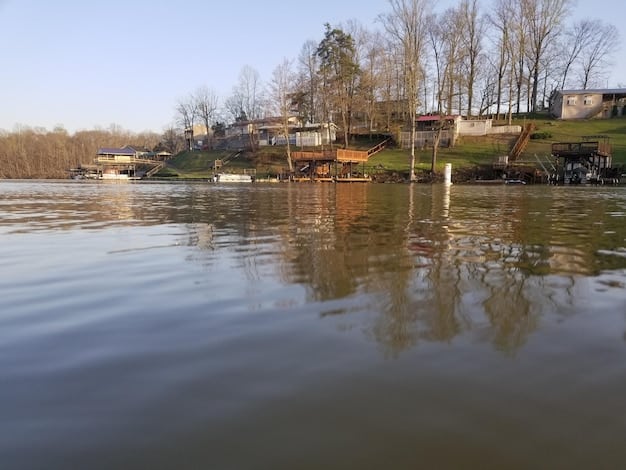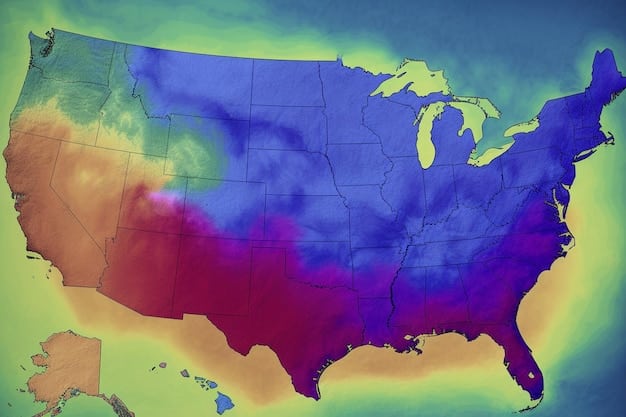Climate Migration: How Many Americans Will Move Due to Climate Change?

Climate migration in the US is projected to displace millions in the next decade due to rising sea levels, extreme weather events, and resource scarcity, necessitating proactive adaptation and policy measures.
Climate migration: How Many Americans Will Be Displaced by Climate Change in the Next Decade? is an increasingly pressing concern as the impacts of global warming intensify across the United States. Rising sea levels, more frequent and severe extreme weather events, and resource scarcity are forcing communities to grapple with the harsh reality of displacement. Understanding the scale of this issue and its potential consequences is crucial for policymakers, urban planners, and individuals alike.
Understanding Climate Migration in the US
Climate migration refers to the movement of people from areas that have become uninhabitable due to the effects of climate change. In the United States, this phenomenon is driven by a range of factors, including sea-level rise, extreme weather events such as hurricanes and wildfires, and droughts leading to water scarcity and agricultural failures.
Key Drivers of Climate Migration
Several key environmental changes are compelling Americans to consider relocating. These include:
Sea-level rise: Coastal communities are increasingly vulnerable to inundation and erosion, making them less habitable.
Extreme weather: More frequent and intense hurricanes, floods, and wildfires are destroying homes and livelihoods.
Drought and water scarcity: Regions experiencing prolonged droughts may become unsustainable for agriculture and daily life.
Vulnerable Regions and Populations
Certain areas and populations are at a higher risk of climate-induced displacement. These include:
- Coastal regions, such as Florida, Louisiana, and the Carolinas
- Arid and semi-arid regions in the Southwest
- Low-income communities that lack the resources to adapt
- Indigenous communities with strong ties to specific lands

Climate models and demographic projections help us understand the scope of potential displacement. However, effective mitigation and adaptation strategies can influence actual migration numbers.
Projected Displacement Numbers in the Next Decade
Estimating the number of Americans who will be displaced by climate change in the next decade is a complex task. Various models and studies offer different projections based on varying assumptions about climate scenarios and adaptive measures.
Range of Projections
Different studies provide a range of estimates:
Conservative estimates: Some suggest that hundreds of thousands of Americans will be displaced.
Moderate estimates: Others project that millions could be forced to relocate.
High-end estimates: A few studies warn that tens of millions might need to move.
Factors Influencing Projections
The variability in projections is due to several factors:
Climate models: Different models use different assumptions about future greenhouse gas emissions and their impact on the climate.
Socioeconomic conditions: The ability of communities to adapt and the availability of resources play a crucial role.
Policy interventions: Government policies, such as investments in infrastructure and managed retreat programs, can significantly affect outcomes.
While it’s difficult to pinpoint an exact number, it is clear that climate migration will be a significant challenge in the coming years.
The Impact on Coastal Communities
Coastal communities are particularly vulnerable to the impacts of climate change, primarily due to sea-level rise and the increasing intensity of coastal storms. These changes threaten infrastructure, property values, and the very existence of many communities.
Sea-Level Rise and Inundation
Rising sea levels are already causing more frequent and severe flooding in coastal areas. This inundation leads to:
Property damage: Homes and businesses are damaged or destroyed by rising waters.
Infrastructure challenges: Roads, bridges, and utilities are compromised, disrupting daily life.
Erosion: Shorelines are eroding, reducing land area and increasing vulnerability to storms.
Increased Storm Intensity
Climate change is amplifying the intensity of coastal storms, such as hurricanes. These storms bring:
- Stronger winds and heavier rainfall
- Increased storm surge
- More widespread damage
Examples of Impacted Areas
Specific regions are already experiencing significant impacts:
Florida: Miami and the Florida Keys are facing existential threats from sea-level rise.
Louisiana: Coastal erosion and subsidence are endangering communities like Isle de Jean Charles.
North Carolina: The Outer Banks are vulnerable to storm surge and shoreline retreat.

These coastal communities are facing difficult decisions about adaptation, relocation, and the future of their way of life.
Inland Migration and Water Scarcity
While coastal regions face inundation, inland areas are grappling with increasing water scarcity due to prolonged droughts and rising temperatures. These conditions are impacting agriculture, economies, and overall livability.
Drought and Agricultural Impact
Many inland regions are experiencing longer and more intense droughts, leading to:
Crop failures: Farmers are struggling to grow crops due to insufficient water.
Livestock losses: Ranchers are facing challenges in providing water for their animals.
Economic disruption: Agricultural communities are suffering economic losses.
Water Supply Challenges
Water scarcity is also impacting municipal water supplies, leading to:
Water restrictions: Communities are implementing measures to conserve water.
Increased competition: Different sectors, such as agriculture, industry, and households, are competing for limited water resources.
Potential conflicts: Water shortages can exacerbate social tensions and conflicts.
Affected Regions
The Southwest is particularly vulnerable:
- California’s Central Valley, a major agricultural region, is struggling with reduced water allocations.
- The Colorado River Basin, which supplies water to several states, is facing severe shortages.
- Communities in Arizona and New Mexico are implementing strict water conservation measures.
These inland regions are increasingly challenged by water scarcity, leading to potential migration and economic shifts.
Policy and Adaptation Strategies
Addressing climate migration requires a combination of policy interventions and adaptation strategies. Governments, communities, and individuals must work together to mitigate the impacts of climate change and prepare for inevitable displacement.
Government Policies
Effective government policies are crucial for:
Mitigation: Reducing greenhouse gas emissions to slow down climate change.
Adaptation: Investing in infrastructure and programs to help communities cope with climate impacts.
Relocation assistance: Providing resources and support for those who need to move.
Community-Based Adaptation
Local communities can implement adaptation strategies such as:
- Building seawalls and levees
- Improving water management practices
- Implementing early warning systems for extreme weather events
- Developing sustainable land-use plans
Individual Actions
Individuals can also play a role in addressing climate migration:
Reducing their carbon footprint: By adopting more sustainable lifestyles.
Preparing for potential displacement: By having emergency plans and resources.
Advocating for policy changes: By supporting initiatives that address climate change.
By combining top-down policies with bottom-up initiatives, the US can better manage climate migration and protect vulnerable populations.
The Socioeconomic Consequences of Climate Migration
Climate migration has significant socioeconomic consequences, affecting both the communities that people leave behind and the areas where they resettle. Understanding these impacts is essential for developing effective responses.
Impacts on Sending Communities
When people leave an area due to climate change, it can lead to:
Economic decline: Businesses lose customers, and property values decrease.
Loss of social fabric: Communities become fragmented as people move away.
Increased inequality: Those who cannot afford to move are left behind in increasingly unsustainable conditions.
Impacts on Receiving Communities
Areas that receive climate migrants may experience:
- Increased demand for housing and services
- Strain on infrastructure, such as water and transportation
- Social tensions between newcomers and existing residents
Addressing the Challenges
To mitigate these negative impacts, it is important to:
Invest in infrastructure: To accommodate new residents in receiving communities.
Provide job training and education: To help migrants integrate into the local economy.
Promote social cohesion: To foster understanding and cooperation between different groups.
By addressing the socioeconomic consequences of climate migration, the US can create more resilient and equitable communities.
| Key Point | Brief Description |
|---|---|
| 🌊 Coastal Risks | Sea-level rise and storms threaten coastal areas, causing displacement. |
| 🏜️ Inland Droughts | Water scarcity impacts agriculture and communities in inland regions. |
| 🏘️ Policy Needs | Government policies and community adaptation are crucial for managing migration. |
| 📈 Socioeconomic Impacts | Migration affects both sending and receiving communities economically and socially. |
Frequently Asked Questions
▼
Climate migration refers to the movement of people from areas that have become uninhabitable due to the impacts of climate change, such as rising sea levels, extreme weather events, and water scarcity.
▼
Coastal areas like Florida, Louisiana, and the Carolinas, as well as arid regions in the Southwest, are particularly vulnerable. Low-income and Indigenous communities are also at higher risk.
▼
Estimates vary, but projections suggest that hundreds of thousands to millions of Americans could be displaced in the next decade due to climate change impacts, depending on mitigation efforts.
▼
Mitigation efforts to reduce greenhouse gas emissions, adaptation strategies to help communities cope, and policies to support relocation and integration are all crucial in addressing climate migration.
▼
Climate migration can lead to economic decline and social fragmentation in sending communities, while placing strain on infrastructure and resources in receiving communities, requiring targeted policy responses.
Conclusion
Climate migration: How Many Americans Will Be Displaced by Climate Change in the Next Decade? is undoubtedly a significant challenge, but understanding the scale of potential displacement and taking proactive measures can help mitigate its impact. By combining effective policies, community-based adaptation strategies, and individual actions, the United States can work towards a more resilient and equitable future for all its citizens.





